The Ministry of Finance has clarified that a resource envelope of US$900m from the Islamic Development Bank (IsDB) is for a pipeline of projects over five years and projects have to be designed to access portions of the resources.
The clarification was issued on Saturday following various reports in the media based on the text of a speech by Minister of Finance Winston Jordan to the 43rd meeting of the IsDB which was held in Tunis, Tunisia from April 1-5, 2018. The speech was released on Thursday.
In the text of his speech, Jordan had stated: “The Bank fielded a programming mission, in December 2017, where a work programme for the three-year period, 2018-2020, was formalized. Financing and technical assistance, of about US$900 million, will be directed to key development areas, including economic infrastructure, rural development, human development and trade and competitiveness”.
This was taken by some in the media to mean that US$900m in loans and grants had been secured. This is not the case as projects now have to be designed to access the funds.
In its clarification on Saturday, the ministry said that it had noted “the conclusion reached by some media houses that Guyana is a recipient of (a) US$900M loan from the Islamic Development Bank (IsDB) and wishes to clarify that contrary to that conclusion, the IsDB has a resource envelope of US900M that is potentially available from which the Government of the Cooperative Republic of Guyana can borrow. The Minister of Finance, Hon. Winston Jordan in his speech to the 43rd Annual Meeting of the IsDB Group was clear in his identification of the named sum”.
The ministry clarification said that during the period 27-29 November 2017, the IsDB mounted a mission to Guyana to develop a medium term work plan for the period 2018- 2022. That work plan outlines a pipeline of projects that the Bank can support over the next five years. However, in his speech, Jordan had cited a three-year work programme for the package, 2018-2010, not five years as now stated in the clarification.
The clarification on Saturday also said that the potential areas of collaboration between the Bank and the government here cover several development sectors including agriculture, banking and finance, human development, energy and rural development.
It added that the current package of potential projects, comprising proposed grant and loan operations is valued at approximately US$900M. The clarification further said that the government is currently in the process of designing projects to commence accessing some portions of the IsDB resources.
In his speech, Jordan adverted to a programme for the Palms Geriatric Home.
He said: “Mr. Chairman, another critical aspect of human development is that of harnessing, caring and paying homage to a nation’s elderly populace. In 2017, the minimum standards for elderly residential care facilities were completed and enacted in Guyana. Concurrently, the Government approached the Bank for its support and assistance to design a project which will modernize and upgrade the facilities of the Palms Geriatric Facility. The project is expected to procure equipment and furniture. It will also result in the provision of enhanced medical care.
“Such a `quick win’ project, Mr. Chairman, is welcomed by the Government, not only for its demonstrative socio-economic impact and benefits, but, also, as evidence of the concretizing of the partnership between the Bank and our country. Indeed, since I last had the honour of addressing this forum, there has been notable progress in our relationship. The Bank fielded a programming mission, in December 2017, where a work programme for the three-year period, 2018-2020, was formalized”.

The Minister also referred to an education project: “Mr. Chairman, human capital development plays a critical role in long-term productivity and growth at both micro and macro levels of any nation. As a consequence, My Government, in partnership with the Bank, has programmed a project to improve national education at the primary and secondary levels. This project will embrace the Inquiry Based Science and Mathematics Education (IBSME) approach. It will also make use of UNESCO’s Global Micro-Science Experiments programme and supporting mathematics kits and will lead to the integration of mathematics through science lessons. This effort will raise the level of scientific and mathematical literacy among teachers and students while supporting a learner-centered environment”.
Jordan also referenced a rice project and said that the government here is “in an advanced stage of designing a Reverse-Linkage Project with the Malaysia Agricultural Research and Development Institute (MARDI), which will assist in updating Guyana’s expertise and technology in rice production. This project will support the introduction of innovative rice varieties that are more resilient and will significantly increase rice yields per acre. I would like to thank the Bank and the Government of Malaysia for the efforts being made to make this endeavour a success”.









